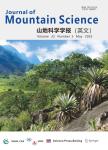版权所有:内蒙古大学图书馆 技术提供:维普资讯• 智图
内蒙古自治区呼和浩特市赛罕区大学西街235号 邮编: 010021

作者机构:Changjiang River Scientific Research Institute China Institute of Water Resources and Hydropower Research Research Center on Flood and Drought Disaster Reduction of the Ministry of Water Resources State Key Laboratory of Hydroscience and Engineering Tsinghua University Gansu Coal Geological Exploration Institute
出 版 物:《Journal of Mountain Science》 (山地科学学报(英文))
年 卷 期:2015年第12卷第5期
页 面:1334-1344页
核心收录:
学科分类:083002[工学-环境工程] 0830[工学-环境科学与工程(可授工学、理学、农学学位)] 08[工学]
基 金:supported by the Specific Research of China Institute of Water Resources and Hydropower Research (Grant Nos. Fangji 1240) Chinese Ministry of Water Resources (Grant Nos. 201301058 and 20131059) the Basic Research Fund for Central Public Research Institutes (Grant No. CKSF2015010/TB)
主 题:Flash floods Building clusters Settlement's distribution Disaster process Fieldmodel experiment
摘 要:In recent years, flash flood disasters have occurred frequently in southwest China due to the increased frequency of extreme climate events. To solve this problem, great efforts have been made in studying the process of flash flood. However, little attention was paid on bearing body of hazard, the clusters of buildings. Thus the real disaster mechanism of flash flood remains ***, based on the experiments of artificial flash floods in a conceptual solid model, this paper focuses on the flood-impacted inundation characteristics of the building clusters at different locations of the gully model, in order to obtain a better understanding of the disaster process and the interaction between the flash floods and building clusters. The results showed that, in a typical smallscale flash flood gully with hot and dry climate, 1)clusters of buildings on an alluvial fan could reduce about 35% of the flooding area by blocking the diffusion of the flood to the depression areas, and could also promote the deposition in lower reaches of the river channel by blocking the overbank flow from going back into the channel, making the width-depth ratio of the channel larger. 2) The flash flood rates of disaster and hazard on the alluvial fan are generally higher than that of the inner gully. For the inner gully,buildings located on the beaches along the lower river and the transitional areas of the straight channel and channel bends can easily be affected because of their lower elevations. For the alluvial fan, buildings nearby the meanders suffer the greatest impacts because of bank collapsing and flooding. 3) The safe vertical distance from a building to the river channel is 13 m for the buildings in the inner gully under extreme floods. Below this threshold, the smaller the vertical distance is, the greater the risk exposure is. For the buildings on the alluvial fan, especially for the buildings near the concave bank of the top rush point,the horizontal distance is more